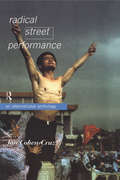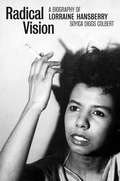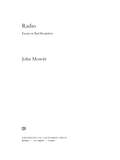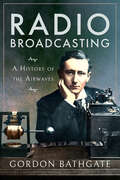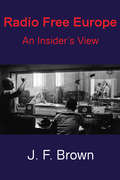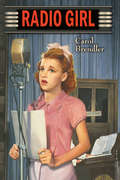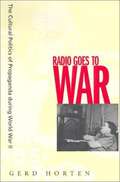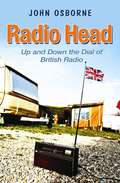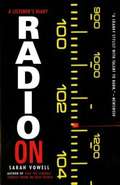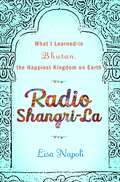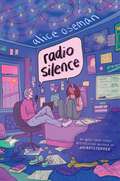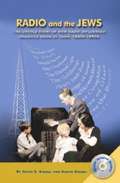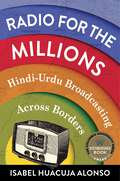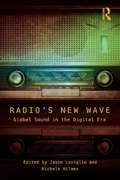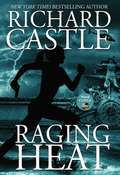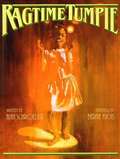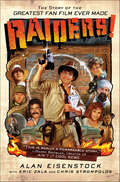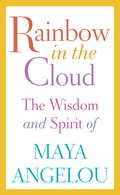- Table View
- List View
Radical Love: Learning to Accept Yourself and Others
by Zachary LeviI'm not an expert, therapist, pastor, teacher, or monk. I am merely a person going through my own mental and emotional health journey, hoping that I can pass on some of the wisdom and tools that I'd been blessed enough to learn along the way. And I truly believe that if we can help heal the hearts and minds of everyone on earth, we will solve every other problem known to man in the process. -- Zachary LeviRadical Love is the debut memoir from Zachary Levi (Shazam!, American Underdog, The Marvelous Mrs. Maisel, Chuck), which shares his emotional journey through a lifetime of crippling anxiety and depression to find joy, gratitude, and ultimate purpose. Facing the scars of childhood trauma and the voices in his head that told him he would never be enough, Zac recounts the raw yet honest behind-the-scenes story of his family life, career successes, and the personal disappointments that led him to rock bottom and landed him in a therapy center, where he learned to address the underlying issues that preceded his downward spiral.Radical Love combines witty, touching, and powerful commentary with relatable illustrations to help you on your own path toward mental wellness. With vulnerability and humor, Zac relates the valuable lessons and insights he&’s learned so that you can rise from the ashes of trauma and pursue a meaningful life of gratitude.
Radical Street Performance: An International Anthology
by Jan Cohen-CruzRadical Street Performance is the first volume to collect together the fascinating array of writings by activists, directors, performers, critics, scholars and journalists who have documented street theatre around the world. More than thirty essays explore the myriad forms this most public of performances can take: * agit-prop * invisible theatre * demonstrations and rallies * direct action * puppetry * parades and pageants * performance art * guerrilla theatre * circuses These essays look at performaces in Europe, Africa, China, India and both the Americas. They describe engagement with issues as diverse as abortion, colonialism, the environment and homophobia, to name only a few. Introduced by editor Jan Cohen-Cruz, the essays are organized into thematic sections: Agitating; Witnessing; Involving; Imagining; and Popularizing. Radical Street Performance is an inspiring testimony to this international performance phenomenon, and an invaluable record of a form of theatre which continues to flourish in a televisual age.
Radical Vision: A Biography of Lorraine Hansberry
by Soyica Diggs ColbertA &“loving, lavishly detailed&” (New York Times) and captivating portrait of Lorraine Hansberry&’s life, art, and political activism—one of O Magazine's best books of April 2021&“Hits the mark as a fresh and timely portrait of an influential playwright.&”—Publishers Weekly In this first scholarly biography of Lorraine Hansberry, Soyica Diggs Colbert narrates a life at the intersection of art and politics, arguing that for Hansberry the theater operated as a rehearsal room for her political and intellectual work. Celebrated for her play A Raisin in the Sun, Hansberry was also the author of innovative journalism and of plays touching on slavery, interracial communities, and Black freedom movements. Hansberry was deeply involved in the Black freedom struggle during the Cold War and in the early civil rights movement, and here Colbert shows us an artist&’s life with the background of the Greenwich Village art scene in the 1960s, the homophile movement, Black diasporic freedom movements, and third-wave feminism. Drawing from Hansberry&’s papers, speeches, and interviews, this book provides a new point of entry in the history of Black radicalism, and a new perspective on Black women in mid‑twentieth‑century political movements.
Radio
by John MowittIn a wide-ranging, cross-cultural, and transhistorical assessment, John Mowitt examines radio's central place in the history of twentieth-century critical theory. A communication apparatus that was a founding technology of twentieth-century mass culture, radio drew the attention of theoretical and philosophical writers such as Jean-Paul Sartre, Walter Benjamin, Jacques Lacan, and Frantz Fanon, who used it as a means to disseminate their ideas. For others, such as Martin Heidegger, Theodor Adorno, and Raymond Williams, radio served as an object of urgent reflection. Mowitt considers how the radio came to matter, especially politically, to phenomenology, existentialism, Hegelian Marxism, anticolonialism, psychoanalysis, and cultural studies. The first systematic examination of the relationship between philosophy and radio, this provocative work also offers a fresh perspective on the role this technology plays today.
Radio Broadcasting: A History of the Airwaves
by Gordon BathgateAn in-depth look at a century of radio history—and its continuing relevance in a radically changed world.A century after Marconi’s experimental transmissions, this book examines the history of radio and traces its development from theories advanced by James Clerk Maxwell and Heinrich Hertz to the first practical demonstrations by Guglielmo Marconi. It looks back to the pioneering broadcasts of the BBC, examines the development of broadcast networks in North America and around the world, and spotlights radio’s role in the Second World War.The book also features the radio programs and radio personalities that made a considerable impact on listeners during the “Golden Era.” It examines how radio, faced by competition from television, adapted and survived. Indeed, radio has continued to thrive despite increased competition from mobile phones, computers, and other technological developments. Radio Broadcasting looks ahead and speculates on how radio will fare in a multi-platform future.
Radio Empire: The BBC’s Eastern Service and the Emergence of the Global Anglophone Novel (Modernist Latitudes)
by Daniel Ryan MorseInitially created to counteract broadcasts from Nazi Germany, the BBC’s Eastern Service became a cauldron of global modernism and an unlikely nexus of artistic exchange. Directed at an educated Indian audience, its programming provided remarkable moments: Listeners in India heard James Joyce reading from Finnegans Wake on the eve of independence, as well as the literary criticism of E. M. Forster and the works of Indian writers living in London.In Radio Empire, Daniel Ryan Morse demonstrates the significance of the Eastern Service for global Anglophone literature and literary broadcasting. He traces how modernist writers used radio to experiment with form and introduce postcolonial literature to global audiences. While innovative authors consciously sought to incorporate radio’s formal features into the novel, literature also exerted a reciprocal and profound influence on twentieth-century broadcasting. Reading Joyce and Forster alongside Attia Hosain, Mulk Raj Anand, and Venu Chitale, Morse demonstrates how the need to appeal to listeners at the edges of the empire pushed the boundaries of literary work in London, inspired high-cultural broadcasting in England, and formed an invisible but influential global network.Adding a transnational perspective to scholarship on radio modernism, Radio Empire demonstrates how the history of broadcasting outside of Western Europe offers a new understanding of the relationship between colonial center and periphery.
Radio Free Europe: An Insider's View
by J. F. BrownThe story of Radio Free Europe’s role during the Cold War, as recounted by veteran RFE official J. F. Brown, who served as director from 1978 to 1983.Jim Brown had written about Eastern Europe from RFE, but never about RFE?until he wrote this book. He conveys his understanding of how Radio Free Europe functioned as a decentralized organization that empowered exiles, while also conveying what it, and they, could?and could not?offer East European listeners. Jim Brown’s explanations of the function of the central news department as an internal news agency, of discussions with and trust of exile broadcast chiefs, of RFE’s cautious approach to broadcasting to Poland under martial law after 1981?to cite only three examples from the book?illuminate the editorial policies and internal relationships that made RFE a success. His portraits of key personalities over the years help us understand that RFE was not just an institution; it was a unique multinational group of people. (From the Foreword by A. Ross Johnson).Praise for Radio Free Europe: An Insider’s View“The historical analysis Brown brings is extremely valuable and adds the insight of a first-rate analyst to such topics as the contrast between how RFE handled the Hungarian and Polish events of the 1950s, the “Czech spring” in 1968, the Gomulka period in Poland, the developing independence of Ceausescu’s Romania, etc. All are given perceptive treatment.” —Eugene R. Parta, co-author of Cold War Broadcasting: Impact on the Soviet Union and Eastern Europe“I know of no other books on RFE by an insider who had so much experience with the Radios and how they were operated. [It is] very well written, well organized, and a fascinating read.” —Yale Richmond, cultural affairs officer, U.S. Foreign Service (ret.), author of Practicing Public Diplomacy: A Cold War Odyssey
Radio Girl
by Carol BrendlerCan a girl from a middle-class Irish Catholic family living in Newark, New Jersey, in 1938 find fame and fortune (or even a job) as a radio star? Tune in to this unforgettable historical novel to find out. Poignant, often hilarious, it's the story of a family in crisis. Just as artful deception, smoke and mirrors characterize radio reality, so lies, secrets, and profound misunderstandings mark fourteen-year-old Cece Maloney's life: her secret job at a radio station, a cheating father, an aunt who may be romantically involved with the parish priest, a boy-crazed best friend, and a ham radio operator and would-be soldier both lying to their parents. The worlds collide on the night of Orson Welles's famous "The War of the Worlds" broadcast. As thousands flee in panic from the alleged Martian invasion, Cece must expose the truth about the radio hoax and confront the truth about her own and her family's dishonesty.
Radio Goes to War: The Cultural Politics of Propaganda During World War II
by Gerd HortenAs a comprehensive and in-depth look at the role of domestic radio in the United States during the Second World War, this study demonstrates how radio broadcasting played a crucial role both in government propaganda and within the context of the broader cultural and political transformations of wartime America and argues that no medium merged entertainment, propaganda, and advertising more effectively than radio.
Radio Head: Up and Down the Dial of British Radio
by John OsborneJohn Osborne has long been a fan of radio - from late night sessions of John Peel to Test Match Special at dawn, he has always enjoyed tuning in to the riches of our best broadcasts. When his dull temporary job became drearier than ever, John decided to remain attached to his headphones all day to listen to some of Britain's more unknown stations as well as revisiting the mainstream to fully experience the breadth of our radio output. The result is a funny, disarming ride through aspects of Britain that are uplifting, informative and sometimes plain bizarre. Throughout his month of intensive radio listening, John flits through talk radio, sports shows, dips into the mainstream and the minority, exalts in specialist music shows, comedy and local radio before expanding his mind with an experimental arts channel. It seems there is something for everyone at the turn of a dial, whether that is the ranting of the permanently enraged, the gentle tinkle of a string quartet, West Indian stomp or the sound of frozen peas being thrown around Elephant and Castle underground station. John also gets under the skin of the radio business by interviewing presenters such as Mark Radcliffe and Nicholas Parsons as well as insiders who run the Radio Times and Channel 4 online radio. John's daily life is directly affected by his radio habit as he finds himself organising a poker night during exposure to The Jazz, and Zane Lowe's energy on Radio One goads him into cooking his stir fry at the same speed as Morecambe and Wise prepared their breakfast. Finally, John decides to turn his life around and radio becomes his saviour.
Radio On: A Listener's Diary
by Sarah VowellCommentary from a frequent contributor to NPR's This American Life.
Radio On: A Listener's Diary
by Sarah VowellThere are approximately 502 million radios in America. For this savvy, far-reaching diary, celebrated journalist and author Sarah Vowell turned hers on and listened--closely, critically, creatively--for an entire year.As a series of impressions and reflections regarding contemporary American culture, and as an extended meditation on both our media and our society, Radio On is a keenly focused book that is as insightful as it is refreshing.
Radio Shangri-La: What I Discovered on my Accidental Journey to the Happiest Kingdom on Earth
by Lisa NapoliLisa Napoli was in the grip of a crisis, dissatisfied with her life and her work as a radio journalist. When a chance encounter with a handsome stranger presented her with an opportunity to move halfway around the world, Lisa left behind cosmopolitan Los Angeles for a new adventure in the ancient Himalayan kingdom of Bhutan--said to be one of the happiest places on earth. Long isolated from industrialization and just beginning to open its doors to the modern world, Bhutan is a deeply spiritual place, devoted to environmental conservation and committed to the happiness of its people--in fact, Bhutan measures its success in Gross National Happiness rather than in GNP. In a country without a single traffic light, its citizens are believed to be among the most content in the world. To Lisa, it seemed to be a place that offered the opposite of her fast-paced life in the United States, where the noisy din of sound-bite news and cell phones dominate our days, and meaningful conversation is a rare commodity; where everyone is plugged in digitally, yet rarely connects with the people around them. Thousands of miles away from everything and everyone she knows, Lisa creates a new community for herself. As she helps to start Bhutan's first youth-oriented radio station, Kuzoo FM, she must come to terms with her conflicting feelings about the impact of the medium on a country that had been shielded from its effects. Immersing herself in Bhutan's rapidly changing culture, Lisa realizes that her own perspective on life is changing as well--and that she is discovering the sense of purpose and joy that she has been yearning for. In this smart, heartfelt, and beautifully written book, sure to please fans of transporting travel narratives and personal memoirs alike, Lisa Napoli discovers that the world is a beautiful and complicated place--and comes to appreciate her life for the adventure it is.From the Hardcover edition.
Radio Silence
by Alice OsemanThe second novel by the phenomenally talented Alice Oseman, the author of the million-copy bestselling Heartstopper books—now a major Netflix series.What if everything you set yourself up to be was wrong?Frances has always been a study machine with one goal: elite university. Nothing will stand in her way. Not friends, not a guilty secret—not even the person she is on the inside.But when Frances meets Aled, the shy genius behind her favorite podcast, she discovers a new freedom. He unlocks the door to Real Frances and for the first time she experiences true friendship, unafraid to be herself. Then the podcast goes viral and the fragile trust between them is broken.Caught between who she was and who she longs to be, Frances’s dreams come crashing down. Suffocating with guilt, she knows that she has to confront her past…She has to confess why Carys disappeared…Meanwhile at university, Aled is alone, fighting even darker secrets.It’s only by facing up to your fears that you can overcome them. And it’s only by being your true self that you can find happiness.Frances is going to need every bit of courage she has.A coming-of-age read that tackles issues of identity, the pressure to succeed, diversity, and freedom to choose, Radio Silence is a tour de force by the most exciting writer of her generation.
Radio and the Gendered Soundscape
by Christine EhrickThis book is a history of women, radio, and the gendered constructions of voice and sound in Buenos Aires, Argentina, and Montevideo, Uruguay. Through the stories of five women and one radio station, this study makes a substantial theoretical contribution to the study of gender, mass media, and political culture and expands our knowledge of these issues beyond the US and Western Europe. Included here is a study of the first all-women's radio station in the Western Hemisphere, an Argentine comedian known as 'Chaplin in Skirts', an author of titillating dramatic serials and, of course, Argentine First Lady 'Evita' Perón. Through the concept of the gendered soundscape, this study integrates sound studies and gender history in new ways, asking readers to consider both the female voice in history and the sonic dimensions of gender.
Radio and the Jews
by David S. Siegel Susan Siegel[From the back cover] The Untold Story of How Radio Influenced America's Image of Jews From stereotypes to role models, the first comprehensive look at how Jews were portrayed on radio from the 1920s to the 1950s. Examines over 100 programs and characters, including comedy, drama, soap opera, religious, documentary and World War II. CD features sample excerpts from programs that stirred listeners' emotions 60 years ago. The Siegels' new book salvages many comedy, drama, and religious programs from obscurity, sheds new light on familiar Jewish-themed programs, and addresses anti-Semitic radio. A highly useful and often entertaining glimpse into Jewish radio, Radio and the Jews is a unique reference for scholars of 20th century radio, media and religion. Tona Hangen, Author of Redeeming the Dial: Radio, Religion, and Popular Culture in America David Siegel has been collecting Golden Age of Radio broadcasts, books and ephemera for over 40 years. He is the editor of The Witch's Tale, an anthology of scripts from a 1930s horror program and co-author of Flashgun Casey, Crime Photographer. Susan Siegel has been involved with radio for 20 years. She has co-authored two reference books about radio with her husband: A Resource Guide to the Golden Age and Radio Scripts in Print.
Radio and the Politics of Sound in Interwar France, 1921–1939
by Rebecca P. ScalesIn December 1921, France broadcast its first public radio program from a transmitter on the Eiffel Tower. In the decade that followed, radio evolved into a mass media capable of reaching millions. Crowds flocked to loudspeakers on city streets to listen to propaganda, children clustered around classroom radios, and families tuned in from their living rooms. Radio and the Politics of Sound in Interwar France, 1921–1939 examines the impact of this auditory culture on French society and politics, revealing how broadcasting became a new platform for political engagement, transforming the act of listening into an important, if highly contested, practice of citizenship. Rejecting models of broadcasting as the weapon of totalitarian regimes or a tool for forging democracy from above, the book offers a more nuanced picture of the politics of radio by uncovering competing interpretations of listening and diverse uses of broadcast sound that flourished between the world wars.
Radio for the Millions: Hindi-Urdu Broadcasting Across Borders
by Isabel Huacuja AlonsoFrom news about World War II to the broadcasting of music from popular movies, radio played a crucial role in an increasingly divided South Asia for more than half a century. Radio for the Millions examines the history of Hindi-Urdu radio during the height of its popularity from the 1930s to the 1980s, showing how it created transnational communities of listeners.Isabel Huacuja Alonso argues that despite British, Indian, and Pakistani politicians’ efforts to usurp the medium for state purposes, radio largely escaped their grasp. She demonstrates that the medium enabled listeners and broadcasters to resist the cultural, linguistic, and political agendas of the British colonial administration and the subsequent independent Indian and Pakistani governments. Rather than being merely a tool of nation building in South Asia, radio created affective links that defied state agendas, policies, and borders. It forged an enduring transnational soundscape, even after the 1947 Partition had made a united India a political impossibility.Huacuja Alonso traces how people engaged with radio across news, music, and drama broadcasts, arguing for a more expansive definition of what it means to listen. She develops the concept of “radio resonance” to understand how radio relied on circuits of oral communication such as rumor and gossip and to account for the affective bonds this “talk” created. By analyzing Hindi film-song radio programs, she demonstrates how radio spurred new ways of listening to cinema. Drawing on a rich collection of sources, including newly recovered recordings, listeners’ letters to radio stations, original interviews with broadcasters, and archival documents from across three continents, Radio for the Millions rethinks assumptions about how the medium connects with audiences.
Radio und Schizophrenie: Zur Radiotheorie der Schizoanalyse
by Ferdinand KlüsenerIn diesem Buch wird eine umfassende Radiotheorie der Schizoanalyse formuliert, die auf wenig erforschten Texten, Praktiken und Archivmaterial basiert. Im Mittelpunkt steht die Relevanz der Schizoanalyse für den ästhetischen Diskurs des 20. Jahrhunderts, insbesondere im Kontext der Radiokunst. Der Autor untersucht die Positionierung dieser Theorie zwischen Theater- und Medienwissenschaften und analysiert deren Beziehung zur Geschichte und Ästhetik des Radios. Durch die Verbindung des mikropolitischen Gestenbegriffs von Deleuze und Guattari mit Konzepten des Gestischen aus dem Lehrstück und deren Verortung in einer Phänomenologie der Zeit jenseits des Tragischen wird ein neuer theoretischer Rahmen geschaffen. Zudem werden bisher unbekannte auditive Objekte für die Historisierung und Kanonisierung der Radiotheorie entdeckt. Methodisch stützt sich die Arbeit auf Performanceanalyse, Medienarchäologie und Interviews mit Akteuren des Feldes. Das Buch leistet einen entscheidenden Beitrag zur Erforschung eines weitgehend unerforschten, aber zentral historisch relevanten Themas und definiert neue theoretische Konzepte für Theorie und Praxis.
Radio's New Wave: Global Sound in the Digital Era
by Jason Loviglio and Michele HilmesRadio’s New Wave explores the evolution of audio media and sound scholarship in the digital age. Extending and updating the focus of their widely acclaimed 2001 book The Radio Reader, Hilmes and Loviglio gather together innovative work by both established and rising scholars to explore the ways that radio has transformed in the digital environment. Contributors explore what sound looks like on screens, how digital listening moves us, new forms of sonic expression, radio’s convergence with mobile media, and the creative activities of old and new audiences. Even radio’s history has been altered by research made possible by digital and global convergence. Together, these twelve concise chapters chart the dissolution of radio’s boundaries and its expansion to include a wide-ranging universe of sound, visuals, tactile interfaces, and cultural roles, as radio rides the digital wave into its second century.
Radio's Second Century: Past, Present, and Future Perspectives
by Bruce Mims John Allen Hendricks Daniel Riffe Brad Clark Mark Ward Lu Wu Laith Zuraikat Joseph R. Blaney David Crider Rachel Sussman-Wander Kaplan John F. Barber Emily W. Easton John Mark Dempsey Anjuli Joshi Brekke Anne F. MacLennan Archie McLean Michael Nevradakis Simon OrderOne of the first books to examine the status of broadcasting on its one hundredth anniversary, Radio’s Second Century investigates both vanguard and perennial topics relevant to radio’s past, present, and future. As the radio industry enters its second century of existence, it continues to be a dominant mass medium with almost total listenership saturation despite rapid technological advancements that provide alternatives for consumers. Lasting influences such as on-air personalities, audience behavior, fan relationships, and localism are analyzed as well as contemporary issues including social and digital media. Other essays examine the regulatory concerns that continue to exist for public radio, commercial radio, and community radio, and discuss the hindrances and challenges posed by government regulation with an emphasis on both American and international perspectives. Radio’s impact on cultural hegemony through creative programming content in the areas of religion, ethnic inclusivity, and gender parity is also explored. Taken together, this volume compromises a meaningful insight into the broadcast industry’s continuing power to inform and entertain listeners around the world via its oldest mass medium--radio.
Raging Heat (Nikki Heat #6)
by Richard CastleIn New York Times Bestselling author Richard Castle's newest novel, an illegal immigrant falls from the sky and NYPD Homicide Detective Nikki Heat's investigation into his death quickly captures the imagination of her boyfriend the Pulitzer Prize-winning journalist, Jameson Rook. When he decides to work the case with Heat as his next big story, Nikki is at first happy to have him ride along. Yes, she must endure Rook's usual wild conspiracy speculations and adolescent wisecracks, but after reuniting following his recent assignment abroad, she's glad for the entertainment, the chance to bounce ideas, and just to be close to him again and feel the old spark rekindle. But when Rook's inquiry concludes that Detective Heat has arrested the wrong man for the murder, everything changes. <P> Balancing her high stakes job with a complicated romance has been a challenge ever since Nikki fell for the famous reporter. Now, her relationship lurches from mere complexity into sharp conflict over the most high-risk case of her career. Set against the raging force of Hurricane Sandy as it pounds New York, Heat battles an ambitious powerbroker, fights a platoon of urban mercenaries, and clashes with the man she loves. Detective Heat knows her job is to solve murders. She just worries that solving this one will be the death of her relationship.
Ragtime Tumpie
by Alan SchroederTumpie, a young black girl who will later become famous as the dancer Josephine Baker, longs to find the opportunity to dance amid the poverty and vivacious street life of St. Louis in the early 1900s.
Raiders!: The Story of the Greatest Fan Film Ever Made
by Alan Eisenstock Eric Zala Chris StrompolosThe official companion book to the hit feature-length documentary, Raiders!: The Story of the Greatest Fan Film Ever Made, in theaters and on video on demand June 27th 2016In 1982, in Ocean Springs, Mississippi, Chris Strompolos, eleven, asked Eric Zala, twelve, a question: "Would you like to help me do a remake Raiders of the Lost Ark? I'm playing Indiana Jones."And they did it. Every shot, every line of dialogue, every stunt.They borrowed and collected costumes, convinced neighborhood kids to wear grass skirts and play natives, cast a fifteen-year-old as Indy's love interest, rounded up seven thousand snakes (sort of), built the Ark, the Idol, the huge boulder, found a desert in Mississippi, and melted the bad guys' faces off.It took seven years.Along the way, Chris had his first kiss (on camera), they nearly burned down the house and incinerated Eric, lived through parents getting divorced and remarried, and watched their friendship disintegrate.Alan Eisenstock's Raiders! is the incredible true story of Eric Zala and Chris Strompolos, how they realized their impossible dream of remaking Raiders of the Lost Ark, and how their friendship survived all challenges, from the building of a six-foot round fiberglass boulder to the devastation of Hurricane Katrina.
Rainbow in the Cloud: The Wisdom and Spirit of Maya Angelou
by Maya Angelou&“Words mean more than what is set down on paper,&” Maya Angelou wrote in her groundbreaking memoir I Know Why the Caged Bird Sings. Indeed, Angelou&’s words have traveled the world and transformed lives—inspiring, strengthening, healing. Through a long and prolific career in letters, she became one of the most celebrated voices of our time. Now, in this collection of sage advice, humorous quips, and pointed observations culled from the author&’s great works, including The Heart of a Woman, On the Pulse of Morning, Gather Together in My Name, and Letter to My Daughter, Maya Angelou&’s spirit endures. Rainbow in the Cloud offers resonant and rewarding quotes on such topics as creativity and culture, family and community, equality and race, values and spirituality, parenting and relationships. Perhaps most special, Maya Angelou&’s only son, Guy Johnson, has contributed some of his mother&’s most powerful sayings, shared directly with him and the members of their family. A treasured keepsake as well as a beautiful tribute to a woman who touched so many, Rainbow in the Cloud reminds us that &“If one has courage, nothing can dim the light which shines from within.&”

